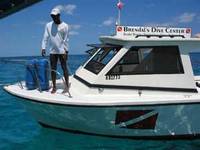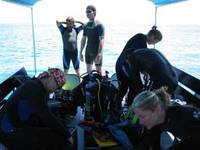April 25, 2005
Brendal, our man in the Bahamas. Monday, April 25th 2005
The Oceana Ranger will be anchored for the next five days off the island of Abaco, in a place called Green Turtle Cay. Early in the morning we meet with Brendal, a Bahamian who has been an institution in this area for more than twenty years because he knows these waters like the palm of his hand, and who will help us to find the best dive sites. The plan from now until Friday is to search for sea turtles, above all the loggerhead (Caretta caretta).

Oceana is working intensely on both sides of the Atlantic to prevent the widespread accidental capture of this species. It is estimated that each year some 40,000 sea turtles – many of them coming from the area where the Ranger is now – fall victim to the hooks of longline fishing boats in the Mediterranean. The Spanish fleet alone accounts for 20,000 of these captures. Although the fishermen don’t intend to do the turtles any harm, they continue to use damaging “J” hooks that cause severe injury. You might remember that last year Carlos Perez, who is now first mate aboard the Ranger, traveled on a longline boat to document the problem. Now, Oceana’s scientists and campaigners are working on a series of projects to compel European governments and authorities to require that “circle hooks,” which are far less damaging to turtles, be used in place of “J” hooks.
We don’t know if we’ll find any, but this is the reason we are looking for loggerheads in the Bahamas, before they begin their long migration towards the Mediterranean.
While Nuño, Carlos, Bibi and David stay on the Ranger to work on the broken port motor, Ricardo and I go with the diving team (Mar, Houssine, Sole and José Carlos). For this first trip Brendal suggests we take the boat of Captain Willis, who guides us first to Fiddle Cay. Willis has lived here all 35 years of his life. “I am a water boy,” he confesses, grinning from ear to ear, “I can’t take more than two weeks in the city.” We were so impressed with his work that we hope to collaborate again.
Submerged in calm, crystalline waters that oscillate between dark blue-greens and lighter shades of turquoise we analyzed three different habitats: a barrier reef, a crest of brown algae, and a marine sea grass prairie.
In the first, hard corals of the genus Porites were dominant, especially mustard coral (Porites astreoides) crowned with elkhorn coral ( Acropora palmata). “Some of these impressive corals, the trunks of which are 15 and 20 centimeters in diameter, have been broken off at the base. It was devastating to see that destruction,” comments Ricardo. “There were pieces of nets caught in corals nearby. The cause of the destruction was clear.”
In the brown seaweed crest, sargassum was dominant (Sargassum platycarpum, different than what we found the other day at Bimini) and dyctiotales (Stypopodium zonale and Padina spp.). There were many juvenile fish, especially damselfish and wrasses. And finally, a mixed prairie of sea grass (Thalassia testudinum y Syringodium filiforme).

Someone gives a shout when we are above the meadow of sea grass. Finally! It looks like a green turtle, but we’re not sure. We try not to lose it from sight while Mar and Houssine prepare their dive equipment so they can follow it. Before she plunges Oceana’s videographer tells us, very seriously, not even to think of going in after them. Those of us with snorkels obey and wait impatiently on deck. Finally, disappointment. Mar has only been able to film it from afar.
The green turtle (Chelonya midas) is the only herbivorous sea turtle. While hawksbill turtles nibble on sponges, the evidence of which we have seen, the green turtle has a serrated beak to cut vegetables, especially the so-called “turtle grass” (Thalassia testudinum) typical of this zone. And unlike the loggerhead and other sea turtles, the green turtle does not migrate over great distances.
In the sea grass meadow there were many equinoderms, like sand dollars (Clypeaster rosaceus) and cushion sea stars (Oreaster reticulates), and fish like the dog snapper (Lutjanus jocu), distinctive because of the black bands that cross over its eyes.
After seven hours working in the water, we return to Green Turtle Cay listening to Willis’ stories. Generations of his family have lived here. “My grandparents ate turtles in soup, or fried. Even I remember having cooked them when I was little. And although there are still a few restaurants in the area that offer turtle as an exotic dish, fortunately most Bahamians understand that we have to protect them now.”


